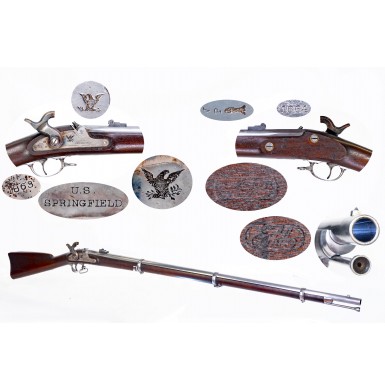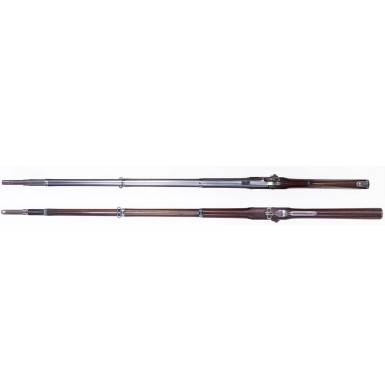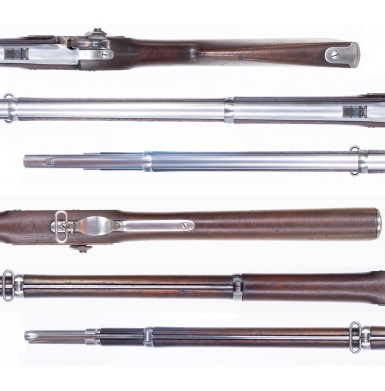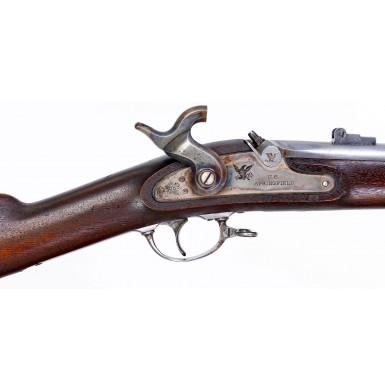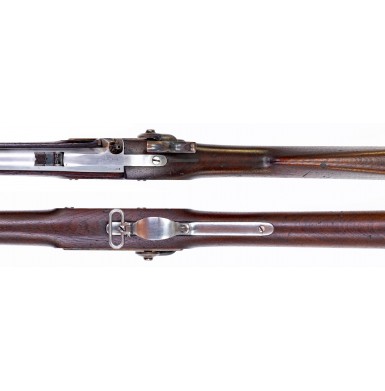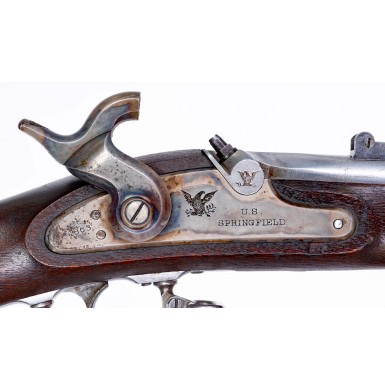Very Fine US Model 1863 Type I Springfield Rifle Musket
- Product Code: FLA-B183-SOLD
- Availability: Out Of Stock
-
$3,500.00
The US Model 1863 Rifle Musket, sometime referred to by collectors as the Model 1863 Type I, approached the pinnacle of American percussion ignition, muzzle loading military long arm design. It also holds the distinction of having been the next to last percussion ignition, muzzleloading long arm to be produced at a National Armory or see service with the US military. The pattern was officially approved on 9 February 1863, and was in production at Springfield Armory by April of that year.
It had been the desire of the Chief of Ordnance, Colonel James Ripley, to produce what would become the Model 1863 Rifle Musket as early as the summer of 1861. However, the pressing need to produce as many rifle muskets at Springfield as possible due to the exigencies of the Civil War prevented the updated rifle musket from entering production for nearly two years. The model in production at that time was the US Model 1861 Rifle Musket, which was a slightly simplified version of the US Model 1855 Rifle Musket which has been updated in 1858 with the adoption of the 1858 pattern leaf rear sight, eliminating the long-base long range rear sight which had originally been part of early 1855 Rifle and Rifle Musket production. By 1860 a general dissatisfaction with the Maynard Tape Priming system used on the Model 1855 series of arms had prompted the Ordnance Department to consider eliminating this complex and somewhat unreliable lock from the design. A general decision to eliminate the Maynard system had been taken by the Ordnance Department in February of 1860, with a general plan to phase out the automatic priming lock put in place, along with some minor changes to the hammer profile and the size of the ramrod’s tulip head. However, this was not pursued with the greatest level of speed.
The firing on Fort Sumter and the outbreak of the American Civil War on April 12, 1861changed everything for the Ordnance Department. Suddenly the need to produce large numbers of rifle muskets was paramount and the plan to get the new Model 1861 Rifle Musket design into production was accelerated. This need was greatly exacerbated by the loss of the Harpers Ferry Arsenal to the Confederacy when Virginia state troops took control of that facility on April 18, 1861, instantly eliminating essentially half of the US Government’s arms production capacity. In an attempt to speed up production of the new Model 1861 Rifle Musket even more, by the end of April 1861 it was decided to eliminate the patchbox from the design, a feature which had appeared on the 1855 Rifle Musket during late 1859.
Another way to increase the production of arms by the US Government was the tried and true system of using outside contractors to manufacture arms. One of the companies approached was the Colt’s Patent Firearms Company of Hartford, CT. Colt designers had analyzed the US Model 1861 Rifle Musket design and led by Elisha Root designed their own version of the gun, which was improved in a number of respects and was also designed with an eye towards easier and faster production. The resulting design would be known as the US Special Model 1861 Rifle Musket was brought to Springfield in June of 1861 where it was approved as a “substitute standard” long arm for production and issue, but also showed that it was an improvement over the current production Model 1861 Springfield Rifle Musket. The primarily Root designed gun has long been considered a sort of “Springfield-Enfield” hybrid and appeared to include some of the best parts of both designs while also focusing on minor changes that could reduce machining and increase the speed of production. The most important improvement over the Model 1861 revolved around the reliability of ignition. The flash channel was shortened and made more direct from the cone (nipple) to the chamber, utilizing a shorter, flat bolster without a clean out screw. This design was both easier to machine and provided more reliable ignition and was a clear improvement. The lock was simplified as well and was a sort of Springfield-Enfield hybrid design. The flat, spring-retained barrel bands of the Springfield were replaced with rounded screw clamping barrel bands similar to those used on the Enfield. Like the Enfield, the Colt design incorporated a spring “spoon” in the stock to apply pressure to the ramrod and retain it in the ramrod channel. This allowed the use of a straight shank ramrod and eliminated the machining of a swelled-shank ramrod as used on the US Models 1855 and 1861 Rifle Muskets with the stock cut with a similar swell at the end of the ramrod channel. Again, the improvements simplified production which meant it made production faster. The other significant improvement from the Colt submission, again designed by Elisha Root, was an improved rear sight design that would be officially adopted as the Pattern 1861 rear sight. This design improved upon the 1858 pattern rear sight by simplifying the machining of the sight leaves by eliminating the curved upper edges and using a straight profile at the top of the leaves and cutting a deeper “V” shaped sighting notch in them. The sight’s base was also improved by recessing the screw that held the leaves in place and redesigning the based to protect the sight leaves. The Ordnance Department was so impressed with the new rear sight design that it was adopted almost immediately and began to be incorporated into the production of US Model 1861 Rifle Muskets by July of 1861. It would be April of 1863 before the US Model 1863 Rifle Musket would enter production, and for all intents and purposes it was the Springfield Arsenal produced version of the Special Model 1861 Rifle Musket. In that month Springfield produced 2,748 of the older Model 1861 Rifle Muskets and 5,064 of the new design. Between April of 1863 and June of 1864 some 273,065 US Model 1863 Rifle Muskets would be produced, with 183,064 made between April and December of 1863 and an additional 90,201 produced between January and June of 1864.
Some aesthetic and functional changes were also made to the appearance of the new Model 1861 Rifle Musket versus the older Model 1861 Rifle Musket. The wrist was increased in girth to increase its strength and the locks which had previously been color casehardened and then polished bright on the Model 1855 and Model 1861 Rifle Muskets were left with their dull mottled case colors visible. Small parts that were blued as a result of the heat drawing process were left with their blued finish, like internal lock parts, the rear sight and trigger. Other small parts like the barrel bands, screws and the triggerguard assembly would eventually be heat blued as well during production, although the initial production examples had those parts polished bright. The checkering pattern on the hammer spur was also changed with the adoption of the Model 1863. When the US Model 1864 Rifle Musket (US Model 1863 Type II to some) was adopted in April of 1864, its design returned to solid barrel bands retained by band springs, eliminating the screw clamping bands. The Model 1864 also adopted a newly designed and simplified rear sight that eliminated the 300-yard leaf and replaced it with a peep hole in the 500-yard leaf. The newer, simpler sight was introduced as it became available, and some Model 1864 Rifle Muskets were produced with the earlier Model 1861 rear sight that had been used on the Model 1863.
Offered here is an extremely crisp example of an 1863 dated US Model 1863 Rifle Musket. The gun is remains in VERY FINE condition and is 100% complete and correct with the exception of a replaced rear sling swivel. The lock retains about 65%+ of its original muted, smoky, mottled case colored finish which has silvered out in some areas and shows some scattered surface oxidation and freckling at the tail. It is clearly marked with a {Spread Winged Eagle} forward of the hammer, as well as U.S. / SPRINGFIELD under the bolster. The tail of the lock is crisply dated 1863. The breech is clearly marked with the date 1864 date, which is not uncommon as the guns were produced during both calendar year. The left angled flat is clearly marked with the usual Springfield V / P / {Eagle Head} view and proof marks. The flat percussion bolster of the barrel is clearly marked with a {Spread Winged Eagle}. The hammer retains about 80%+ mottled case coloring which is somewhat muted and shows some dulling from age but is more vibrant than on the lock. The lock functions perfectly on all positions and is very crisp. It is mechanically excellent in every way. The barrel of the gun has a medium bright steel color to it and was likely lightly cleaned at some point in the past. The barrel shows some very lightly scattered areas of minor freckled oxidation and age discoloration, and a few tiny areas of lightly scattered minor pinpricking. The bore of the rifle musket is very crisp and mostly bright with excellent rifling and some scattered oxidation. The furniture of the rifle musket matches the barrel well and retains much of the appearance of its original arsenal bright polish, with some scattered areas of lightly oxidized age discoloration and freckled oxidation. The gun retains the original upper sling swivel on the middle barrel band’s lug, and has a screw retained replacement lower sling swivel on the bow of the triggerguard. The original and correct 1861 pattern long-range rear sight is in place and the sight retains the much of its original blued finish. The original musket pattern front sight and lug for the angular socket bayonet is in place on top of the barrel, near the muzzle. The ramrod is an original, correct pattern straight shank tulip head ramrod, which is full-length with good threads on the end. The stock of the rifle is in VERY FINE condition as well. It is full length and solid and shows no breaks, cracks, or repairs. The stock does not appear to have ever been sanded and retains well-defined edges. The wood even retains some traces of the feathery texture found on like new condition muskets. The stock flat, opposite the lock bears two very nice inspectors, cartouches. The very clear and crisp script ESAfor Erskine S Allin, the master armorer at Springfield Armory appears to the rear of the counterpane in the final inspection location. A less clear script cartouche that appears to be the TBH of Springfield sub-inspector Thoams B. Hawks is in the sub-inspection position to the rear of the rear lock screw. The stock has a lovely rich brown color to it and very attractive grain throughout. The stock shows a handful of minor bumps, dings and bruises from light use and storage over the last 160 years, but absolutely no abuse.
Overall, this is a really high condition example of a desirable US Model 1863 Rifle Musket. These were the last of the Civil War era, arsenal produced rifle muskets to be issued in any quantity and a large quantity of these guns were subsequently altered to breechloaders or disassembled to scavenge their parts for newly produced arms in the post-Civil War period. Since so many did see significant field service during the last two years of the war and many were altered to breechloaders during the late 1860s and early 1870s, finding a high condition example in original condition can be difficult. This is a fine example that you will be proud to add to your Civil War long arms collection and will certainly enjoy displaying.
Tags: Very, Fine, US, Model, 1863, Type, I, Springfield, Rifle, Musket

